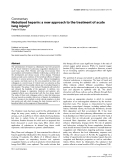
Approach to the acutely
-
Guidelines and recommendations developed and/or endorsed by the American College of Rheumatology (ACR) are intended to provide guidance for particular patterns of practice and not to dictate the care of a particular patient.
 15p
15p  tramnamcodon_01
tramnamcodon_01
 28-03-2016
28-03-2016
 68
68
 2
2
 Download
Download
-
Tuyển tập các báo cáo nghiên cứu về y học được đăng trên tạp chí y học Critical Care giúp cho các bạn có thêm kiến thức về ngành y học đề tài: Nebulised heparin: a new approach to the treatment of acute lung injury?
 2p
2p  coxanh_4
coxanh_4
 27-10-2011
27-10-2011
 61
61
 4
4
 Download
Download
CHỦ ĐỀ BẠN MUỐN TÌM














